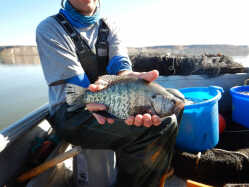Multi-year study evaluates panfish production at C.J. Strike Reservoir

C.J. Strike Reservoir is one of the most popular fisheries in southwest Idaho. Situated at the confluence of the Snake and Bruneau rivers, the C.J. Strike Dam was completed in 1952 creating a 6,700 acre reservoir. This large waterbody offers a diverse fishery, from rainbow trout to white sturgeon to smallmouth bass. However, the reservoir’s panfish species (specifically crappie and yellow perch) are by far the most popular among anglers. With numerous boat launches and campgrounds located about an hour drive from the Treasure Valley, the reservoir is an especially popular destination for anglers looking to catch some of Idaho’s tastiest freshwater species. The crappie fishing has been exceptionally popular this spring with many anglers having great success.
If you are one of the many anglers who have spent time on C.J. Strike Reservoir this spring, you may have noticed Idaho Fish and Game employees on the water. Southwest regional fisheries staff have been busy sampling this reservoir as part of an ongoing multi-year assessment of panfish population dynamics. We use numerous gear types to sample all size classes of crappie and yellow perch in the reservoir to identify year-class strength. In the spring, gill nets, trap nets and boat electrofishing are used to sample these populations. Throughout the month of June, we use a fine meshed net to sample larval fish produced in each year’s spawning cycle and compare this production to previous years. Zooplankton sampling also takes place from May through October to evaluate the amount of food available for growing juvenile fish. In the fall, we again sample the populations with gill nets, trap nets, and boat electrofishing but also include otter trawling to further evaluate the survival of both adult and juvenile fish over the summer.
In addition to length and weight data collected on captured fish, dorsal fin spines are also clipped from adult crappie to estimate age. Using age and length data together, we are able to estimate growth rates. Angler harvest of crappie is also estimated by both tagging captured fish and then retrieving data reported by anglers from the Tag! You’re It database and through spring and fall angler check stations. This sampling protocol was implemented in 2016 and will likely continue until approximately 2022.
Based on age estimates, the vast majority of crappie captured in this year’s spring survey were produced in the 2017 spawn and they are now over three years old with an average size just over nine inches. Crappie life cycles often exhibit these boom and bust year classes like we have seen with the booming 2017 cohort. These crappie will likely begin to taper off in the next few years as age and spawning stress take their toll on this portion of the population. So if you’re looking for an exciting and active fishing experience, try your hand at crappie fishing at C.J. Strike Reservoir this year. You can find more information about the reservoir’s fish species, regulations, stocking and access on the IDFG Fishing Planner.
